Travel & Tourism
jacksonville flight discontinuations: What travelers need to know
Published
2 weeks agoon
By
Owner
Travelers and local businesses have noticed a wave of route changes recently, and the phrase jacksonville flight discontinuations has been appearing more often in news headlines and travel forums. This article explains what those changes mean, why airlines are trimming service, and how passengers can adapt without losing access to the destinations they need. The aim is to provide clear, practical information you can use to plan trips, adjust expectations, and understand the airport’s broader traffic picture.
Recent route changes at JAX
Local reporting shows several carriers have removed or suspended select non-stop routes out of Jacksonville International Airport, creating a spike in searches and questions about jacksonville flight discontinuations. These changes include a mix of permanent route cuts and seasonal suspensions that were announced as carriers reevaluate their winter and spring schedules.
Notable route examples
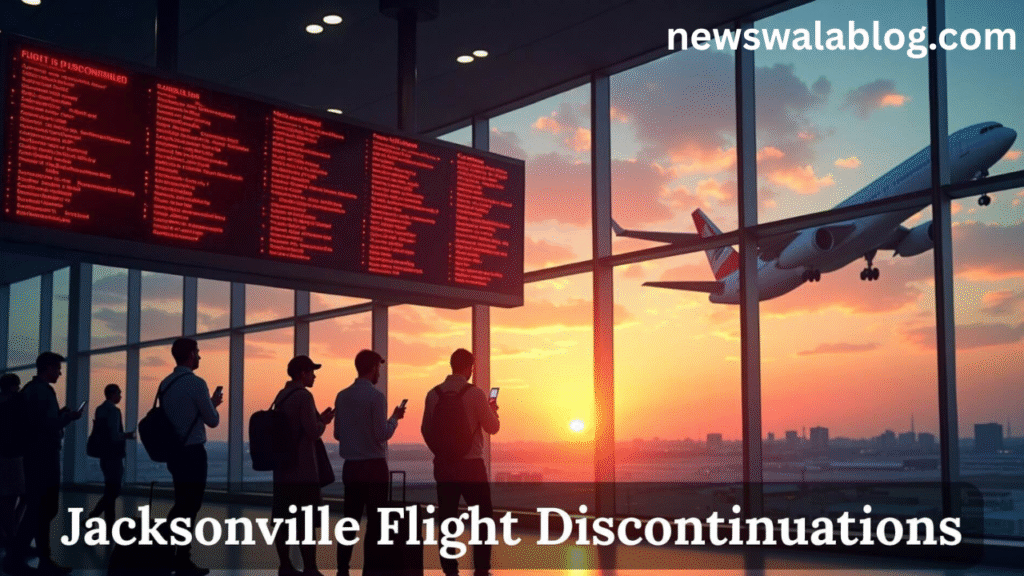
JetBlue recently ended its nonstop service between Jacksonville and Fort Lauderdale as part of a schedule reshuffle, a move that surprised frequent flyers who relied on the quick hop to South Florida. Southwest also stopped flying the direct route between Jacksonville and Atlanta in early April, shifting capacity to other markets. Both announcements were noted by airport officials and local outlets when the changes took effect.
Another high-profile change involves international connections: Air Canada has suspended its winter Toronto–Jacksonville service for the coming winter season, a decision that affects Canadians who winter in northeast Florida and travelers looking for direct cross-border service. These adjustments are being framed by carriers as seasonal reductions or temporary suspensions, though they can sometimes become permanent depending on demand.
Why airlines are pruning routes
Airlines regularly adjust routes for several predictable reasons, which help explain the recent jacksonville flight discontinuations. First, seasonality plays a major role: certain non-stop services are only economical during peak travel months and are suspended during slower winter periods. Second, airlines constantly evaluate route economics — if a route underperforms in load factor or revenue per seat, it becomes a target for reduction. Third, broader network strategies, such as concentrating capacity at larger hubs or reallocating aircraft to more profitable corridors, also lead to cuts in marginal markets. These strategic considerations have been driving several recent route decisions across carriers.
What the airport numbers show
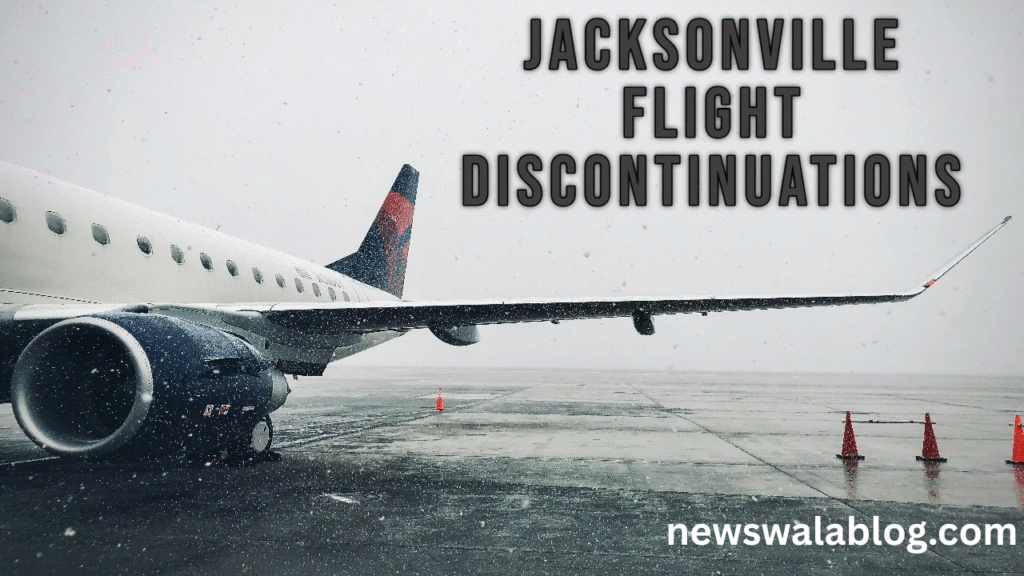
Airport traffic can help explain why carriers make these choices. Jacksonville International Airport’s publicly reported monthly metrics show fluctuations in passenger volumes that airlines factor into their planning. Airport officials pointed to a slight year-over-year dip in passenger counts during the spring period when some cuts were announced, and at the same time have highlighted other months of growth as new routes come online. Monitoring these trends gives context to jacksonville flight discontinuations and indicates whether a route is likely to return.
What this means for travelers
For passengers, jacksonville flight discontinuations can translate into longer connections, higher fares on remaining non-stop routes, or a need to use nearby airports for direct service. Travelers who previously used a removed non-stop may now have to connect through larger hubs, add driving time to alternative airports, or book with a different carrier. That said, many reductions are seasonal — routes often return in the busy summer months — so it’s worth checking seasonal schedules before rebooking long-term travel plans.
How to adapt — practical tips
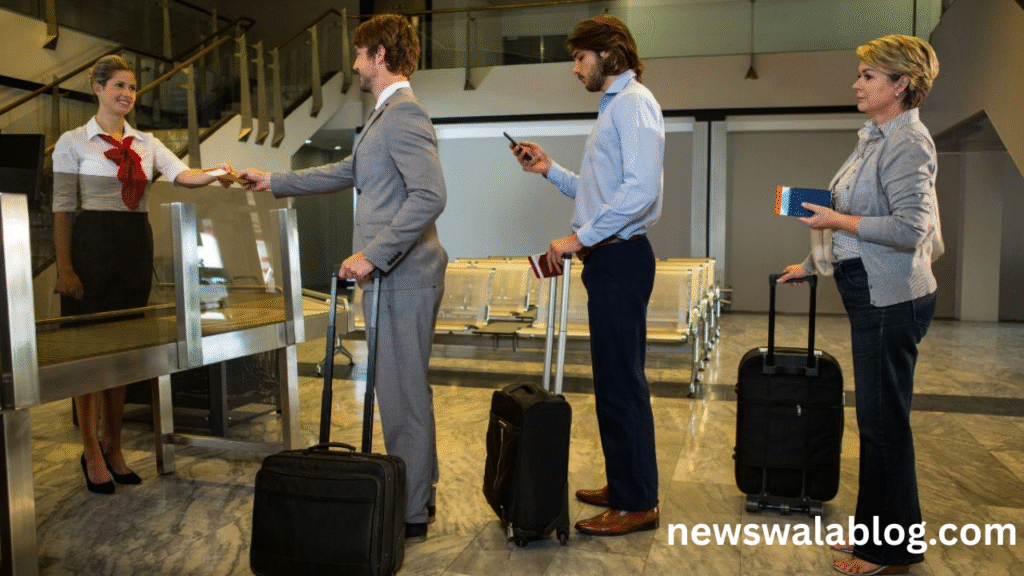
- Be flexible with dates and airports. If a nonstop is gone, moving travel by a day or two or flying into a neighboring airport may open better connections and lower fares.
- Book refundable or changeable tickets if plans might shift. Airlines sometimes restore routes mid-year, so flexible fares reduce stress.
- Monitor carrier announcements and the airport’s schedule page. Official schedule updates and airport dashboards are the fastest way to know whether a service is suspended temporarily or ended permanently.
- Consider multi-carrier itineraries. Mixing carriers for outbound and return legs can save time even if a nonstop disappears.
Airport and community response
Airport leadership and local tourism partners generally respond to jacksonville flight discontinuations by engaging with carriers and promoting demand for at-risk routes. Airports can offer marketing support, co-op fare promotions, or adjust gate and ground resources to make a proposed route more attractive. While this doesn’t guarantee a route will return, coordinated community interest and stable passenger numbers are often significant factors when airlines re-evaluate service.
Looking ahead
Not every discontinuation is permanent. Some routes are paused for winter and return for summer demand; others are reintroduced with different frequencies or aircraft types. Travelers and businesses should track official airline schedules and airport reports over the next few quarters to see whether the current wave of jacksonville flight discontinuations stabilizes or reverses. If the airport’s passenger numbers climb back up and demand is demonstrable, carriers are more likely to restore direct service.
Frequently Asked Questions (FAQs)
Q1: Are the recent cuts at Jacksonville permanent?
A: Some are seasonal pauses while others may be permanent depending on performance. Check airline notices and the airport schedule for confirmation.
Q2: How can I find alternative routes if my nonstop is discontinued?
A: Look for connecting flights via major hubs, compare fares at nearby airports, and consider flexible dates to find the best options.
Q3: Will fares rise after these discontinuations?
A: Reduced competition on a route can push fares higher, but dynamic pricing and alternative connections may still yield good deals.
Q4: Does the airport do anything to bring routes back?
A: Airports often partner with local stakeholders to market and support routes; success depends on sustained passenger demand.
Q5: Where can I get the most current schedule information?
A: The official Jacksonville International Airport website and airline schedule pages provide the most reliable, up-to-date information.
Conclusion
jacksonville flight discontinuations reflect a mix of seasonal demand shifts, airline network decisions, and local passenger trends. While losing a nonstop is inconvenient, many changes are temporary and tied to predictable schedule economics. By staying informed through official airline and airport channels, using flexible travel strategies, and monitoring regional passenger trends, travelers can minimize disruption and find suitable alternatives when direct service is reduced. If you rely on any specific nonstop route, keep a close eye on carrier announcements — routes sometimes return when demand rebounds.
read more: Ywmlfz 48w cordless: Compact 48W Portable Nail Lamp
You may like
Travel & Tourism
Veneajelu The Ultimate Finnish Boating Experience Guide
Published
1 month agoon
August 28, 2025By
Owner
Introduction & Definition
What is Veneajelu?
Veneajelu represents one of Finland’s most cherished traditions – the art of leisurely boat excursions that connect people with the country’s stunning waterways. This uniquely Finnish experience combines relaxation, adventure, and cultural appreciation into unforgettable journeys across pristine lakes and coastal waters.
Etymology and Finnish Cultural Significance
The term veneajelu originates from two Finnish words: “vene” meaning boat and “ajelu” meaning ride or trip. This simple combination captures the essence of an activity deeply woven into Finnish culture, where water-based recreation holds special significance in the national identity.
Overview of the Boat Trip Experience
A typical veneajelu offers participants the chance to explore Finland’s remarkable aquatic landscapes while experiencing the tranquility that comes from being surrounded by nature. These excursions range from short afternoon trips to extended multi-day adventures, each designed to showcase the natural beauty that makes Finland’s waterways world-renowned.
Why Veneajelu Matters in Finnish Culture
For Finns, veneajelu represents more than simple recreation – it embodies their deep connection to nature and water. This cultural practice reflects the Finnish values of peace, reflection, and environmental appreciation, making it an essential experience for anyone seeking to understand Finnish lifestyle.
Cultural & Historical Context

Maritime Traditions in Finland
Finland’s extensive maritime heritage spans centuries, with waterways serving as crucial transportation routes long before modern infrastructure existed. These historical connections to water naturally evolved into recreational pursuits, with veneajelu becoming a beloved way to honor this maritime legacy.
Evolution from Necessity to Leisure Activity
What once served as practical transportation has transformed into one of Finland’s most popular leisure activities. Modern veneajelu experiences preserve traditional elements while incorporating contemporary comfort and safety standards, creating perfect harmony between past and present.
Connection to Finnish Lifestyle and Nature Appreciation
The Finnish concept of being close to nature finds perfect expression through veneajelu. These boat trips provide opportunities for mental restoration and spiritual connection with the environment, aligning perfectly with Finnish values of sustainability and natural harmony.
Role in Finnish Tourism and Heritage
Today’s veneajelu serves as a cornerstone of Finnish tourism, offering visitors authentic cultural experiences while supporting local communities. This activity has become essential for showcasing Finland’s natural treasures to international guests seeking genuine Nordic experiences.
Types of Veneajelu Experiences

Lake Cruises and Inland Waterways
Finland’s thousands of lakes provide endless opportunities for memorable veneajelu adventures. These inland excursions offer peaceful journeys through mirror-like waters surrounded by pristine forests, creating ideal conditions for relaxation and wildlife observation.
River Excursions
River-based veneajelu experiences provide unique perspectives on Finland’s diverse landscapes. These trips often feature varying scenery as waterways wind through different terrain types, from dense woodlands to open meadows.
Coastal and Archipelago Tours
Coastal veneajelu adventures showcase Finland’s remarkable archipelago regions, where countless islands create maze-like waterways perfect for exploration. These excursions often include stops at historic sites and charming coastal communities.
Luxury Yacht Experiences
For those seeking premium veneajelu experiences, luxury yacht options provide exceptional comfort while maintaining authentic Finnish character. These high-end trips often include gourmet dining and exclusive access to pristine locations.
Traditional Boat Rides
Traditional veneajelu experiences use classic Finnish vessels, preserving historical authenticity while providing insight into maritime heritage. These trips offer cultural education alongside natural beauty appreciation.
Sauna Boat Experiences (Saunalautta)
The ultimate Finnish veneajelu combines two national passions – boating and sauna culture. These unique experiences allow participants to enjoy traditional sauna sessions while surrounded by Finland’s beautiful waterways.
Popular Destinations & Routes

Helsinki Archipelago Tours
Veneajelu Helsinki experiences rank among Finland’s most popular water excursions, offering access to the stunning archipelago surrounding the capital. These trips provide perfect introductions to Finnish boating culture while showcasing the region’s natural and cultural attractions.
The Helsinki archipelago contains hundreds of islands, each offering unique characteristics and experiences. Veneajelu Helsinki operators provide various route options, from short city harbor tours to full-day island-hopping adventures that reveal hidden gems throughout the region.
Finnish Lake Regions
Beyond Helsinki, Finland’s extensive lake regions offer countless veneajelu opportunities. These inland destinations provide different experiences from coastal trips, featuring calm waters surrounded by dense forests and traditional Finnish summer cottages.
Best Waterways for Veneajelu
Finland’s diverse waterways each offer distinct advantages for different types of excursions. Some regions excel for wildlife viewing, others for cultural experiences, and many provide perfect combinations of natural beauty and recreational opportunities.
Seasonal Considerations
Veneajelu experiences vary significantly by season, with summer months providing optimal conditions for most activities. However, each season offers unique advantages, from spring ice-break observations to autumn foliage viewing opportunities.
Hidden Gems and Local Favorites
Experienced veneajelu enthusiasts often discover lesser-known locations that provide exceptional experiences away from crowded tourist areas. These hidden destinations offer opportunities for more intimate connections with Finnish nature and culture.
Planning Your Veneajelu
Best Times to Visit
Optimal veneajelu conditions typically occur during Finland’s summer months when weather remains mild and daylight hours extend significantly. However, different seasons offer unique advantages for specific types of experiences and personal preferences.
Booking Considerations
Successful veneajelu planning requires advance booking, especially during peak summer months when demand reaches highest levels. Early reservations ensure access to preferred dates and times while often providing better pricing options.
What to Expect During the Trip
Typical veneajelu experiences include safety briefings, equipment orientation, and guided commentary about local history and wildlife. Participants should prepare for varying weather conditions and pack accordingly for comfortable enjoyment throughout their excursion.
Duration Options
Veneajelu experiences accommodate various schedule preferences, from brief introductory trips lasting a few hours to comprehensive multi-day adventures that include overnight accommodation and extensive exploration opportunities.
Group Sizes and Customization Options
Most veneajelu operators offer flexible group sizes and customization options to meet specific interests and requirements. Private charter options provide maximum flexibility for special occasions or specific interests.
What to Bring & Prepare
Essential Items for Boat Trips
Successful veneajelu experiences require proper preparation with weather-appropriate clothing, sun protection, and personal comfort items. Participants should pack layers to accommodate changing conditions throughout their excursion.
Weather Considerations
Finnish weather can change rapidly, making preparation essential for enjoyable veneajelu experiences. Waterproof clothing and warm layers ensure comfort regardless of conditions encountered during excursions.
Safety Equipment
Professional veneajelu operators provide all necessary safety equipment, including life jackets and emergency communication devices. Participants should familiarize themselves with safety procedures and equipment locations before departure.
Photography Tips for Water Excursions
Veneajelu provides exceptional photography opportunities, requiring specific techniques for water-based shooting. Participants should protect equipment from water exposure while positioning themselves for optimal lighting and composition opportunities.
Environmental Responsibility
Protecting Finland’s Pristine Waterways
Responsible veneajelu practices help preserve Finland’s remarkable aquatic environments for future generations. Participants play crucial roles in maintaining water quality and ecosystem health through conscious behavior choices.
Sustainable Boating Practices
Modern veneajelu operators increasingly emphasize sustainable practices that minimize environmental impact while maximizing cultural and natural appreciation. These approaches ensure long-term viability for both tourism and ecosystem health.
Conservation Efforts
Many veneajelu experiences include educational components about local conservation efforts and environmental protection initiatives. These programs help participants understand their roles in preserving Finland’s natural treasures.
Leave No Trace Principles
Successful veneajelu experiences follow Leave No Trace principles, ensuring minimal environmental impact while maximizing appreciation for natural beauty. These practices protect sensitive ecosystems while maintaining access for future visitors.
Benefits & Experiences
Connection with Nature
Veneajelu provides unparalleled opportunities for deep connection with Finland’s natural environments. These experiences offer mental restoration and spiritual renewal through immersion in pristine aquatic landscapes.
Relaxation and Wellness Aspects
The gentle motion of boats combined with peaceful natural surroundings creates ideal conditions for stress relief and mental rejuvenation. Many participants report significant wellness benefits from their veneajelu experiences.
Adventure and Exploration
Each veneajelu offers opportunities for discovery and adventure, whether exploring hidden coves, observing wildlife, or learning about local history and culture. These experiences satisfy curiosity while providing safe adventure opportunities.
Family-Friendly Activities
Veneajelu experiences accommodate participants of all ages, making them perfect for family bonding and multi-generational activities. These trips create lasting memories while providing educational opportunities for younger participants.
Cultural Immersion Opportunities
Authentic veneajelu experiences provide deep insights into Finnish culture and lifestyle, offering perspectives unavailable through other tourism activities. These cultural connections enhance understanding and appreciation of Finnish values and traditions.
Safety & Practical Information
Safety Guidelines and Regulations
Professional veneajelu operations maintain strict safety standards and follow comprehensive regulations designed to ensure participant welfare. These guidelines cover everything from equipment maintenance to emergency response procedures.
Weather Considerations
Finnish weather patterns require careful monitoring and flexible planning for optimal veneajelu experiences. Professional operators maintain detailed weather tracking systems and adjust schedules as necessary for safety and comfort.
Emergency Procedures
All legitimate veneajelu operators maintain comprehensive emergency response capabilities, including communication systems, medical supplies, and evacuation procedures. Participants receive briefings on emergency protocols before departure.
Insurance and Liability
Responsible veneajelu booking includes verification of operator insurance coverage and understanding of participant responsibilities. Professional operators maintain comprehensive coverage while clearly communicating participant expectations and limitations.
Conclusion
Why Veneajelu is a Must-Try Experience
Veneajelu represents the perfect combination of cultural authenticity, natural beauty, and recreational enjoyment that defines the best of Finnish tourism. These experiences provide unique perspectives on Finnish lifestyle while creating lasting memories of remarkable natural environments.
Summary of Key Benefits
From cultural immersion to natural connection, veneajelu offers multiple benefits that appeal to diverse interests and preferences. Whether seeking relaxation, adventure, education, or cultural understanding, these experiences deliver exceptional value and satisfaction.
Call to Action for Planning Your Trip
Finland’s remarkable waterways await exploration through authentic veneajelu experiences that showcase the country’s natural beauty and cultural heritage. Begin planning your perfect Finnish boat adventure today to discover why this traditional activity continues capturing hearts and imaginations worldwide.
Also Read: Booking.com Removes Spanish Holiday Lets Spain’s Major Tourism Crackdown
Travel & Tourism
Booking.com Removes Spanish Holiday Lets Spain’s Major Tourism Crackdown
Published
1 month agoon
August 25, 2025By
Owner
The Spanish government has taken decisive action in its fight against illegal holiday rentals, resulting in a significant crackdown that has sent shockwaves through the tourism industry. In a move that highlights the country’s commitment to regulatory compliance, booking.com removes spanish holiday lets by the thousands, marking one of the most substantial enforcement actions in recent years. This decisive action where booking com removes spanish holiday lets represents a turning point in Spain’s approach to tourism regulation.
The Scale of Spain’s Holiday Rental Crackdown
The numbers tell a compelling story of regulatory enforcement. Spanish authorities successfully compelled the removal of over 4,000 holiday rental listings from major booking platforms, with the majority concentrated in popular tourist destinations. This massive action demonstrates the government’s serious approach to addressing the growing concerns surrounding unregistered accommodation providers. The enforcement action where booking.com removes spanish holiday lets has become a model for other European destinations facing similar challenges.
The Canary Islands bore the brunt of these removals, reflecting the region’s popularity among international tourists and the prevalence of unregistered properties. Other affected regions included Asturias, Cantabria, Castilla y León, Navarra, La Rioja, and Castilla-La Mancha, showing the nationwide scope of the enforcement effort. The systematic approach where booking com removes spanish holiday lets ensures comprehensive coverage across all major tourist regions.
Understanding the Legal Framework Behind the Removals
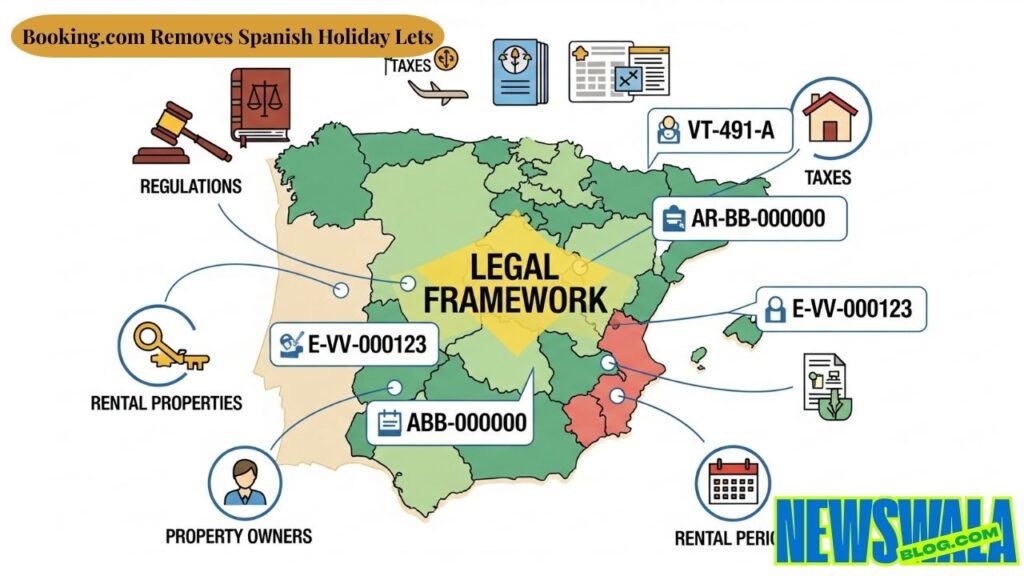
Spain’s approach to holiday rental regulation has become increasingly stringent, driven by both local housing concerns and European-wide standards. The Ministry of Social Rights, Consumption, and the 2030 Agenda has taken an active role in identifying and addressing properties operating without proper authorization.
New European regulations introduced a critical requirement: all holiday rental accommodations must display proper identification numbers by July 1st, 2025. This deadline created a clear benchmark for compliance, and properties failing to meet these standards faced immediate removal from booking platforms.
The government’s registry system requires all tourist accommodations to obtain proper licenses and maintain current registration status. This comprehensive approach ensures that visitors book legitimate, safe, and legally compliant properties while protecting local communities from the negative impacts of unregulated tourism.
Why Properties Were Removed from Booking Platforms

The reasons behind the large-scale removal of listings were multifaceted and centered on legal compliance issues. Many properties lacked essential tourist accommodation licenses, making their operation illegal under Spanish law. Others failed to complete the mandatory registration process within specified timeframes. The comprehensive approach where booking.com removes spanish holiday lets ensures that only legally compliant properties remain available to tourists.
Consumer protection violations also played a significant role in the enforcement action. Properties operating without proper oversight often failed to meet safety standards and consumer rights requirements, potentially putting visitors at risk and undermining confidence in Spain’s tourism sector. The thorough process where booking com removes spanish holiday lets prioritizes visitor safety and legal compliance above all other considerations.
Non-compliance with identification number requirements became a primary factor in determining which properties faced removal. The clear deadline and straightforward requirements left little room for ambiguity, making enforcement both fair and effective.
Spain’s Broader Policy Response to Tourism Challenges

This enforcement action represents just one component of Spain’s comprehensive approach to managing tourism’s impact on local communities. The country faces significant challenges related to housing affordability and overtourism in popular destinations, prompting a multifaceted policy response.
Barcelona has announced particularly ambitious plans, with authorities planning to withdraw all 10,101 tourist accommodation licenses by November 2028. This dramatic step reflects growing concerns about tourism’s impact on residential housing availability and local quality of life.
Regional governments have implemented varying approaches to enforcement, recognizing that different areas face unique challenges. While some regions focus on reducing overall accommodation numbers, others prioritize ensuring existing properties meet legal standards.
Industry Response and Platform Cooperation
The cooperation between Spanish authorities and major booking platforms has been notable throughout this process. The recent action where booking.com removes spanish holiday lets demonstrates the platforms’ willingness to work within legal frameworks rather than resist regulatory efforts. This collaborative approach has made the enforcement process more efficient and comprehensive.
Similar actions have affected other major platforms, with Airbnb and other accommodation providers also removing unregistered listings in response to Spanish enforcement efforts. This coordinated approach ensures that regulatory standards apply equally across all booking channels. The precedent set when booking com removes spanish holiday lets has encouraged other platforms to proactively review their listings for compliance issues.
Platform operators have implemented enhanced verification processes to prevent future compliance issues. These measures include improved document checking systems and regular audits of listed properties to ensure ongoing compliance with local regulations.
Impact on Property Owners and the Tourism Sector
The enforcement action has created significant impacts for property owners who previously operated without proper authorization. Many face the choice between obtaining proper licenses or exiting the holiday rental market entirely.
The tourism industry has responded with mixed reactions. While some operators welcome increased regulation as a way to ensure fair competition and maintain quality standards, others worry about reduced accommodation capacity and potential impacts on visitor numbers.
Local communities have generally supported the enforcement efforts, viewing them as necessary steps to address housing affordability concerns and manage tourism’s impact on residential areas. The removal of illegal properties helps level the playing field between legal operators and unauthorized providers.
Economic Consequences and Market Effects
The large-scale removal of holiday rental properties has created notable economic consequences across affected regions. Legal accommodation providers may benefit from reduced competition, potentially leading to improved occupancy rates and pricing power.
Property owners who lost rental income face financial adjustments, though many retain the option to obtain proper licensing and return to legal operation. The transition period has created uncertainty in local property markets as investors reassess the viability of holiday rental investments.
Tourism destinations must now balance accommodation capacity with regulatory compliance, potentially affecting visitor numbers during peak seasons. However, authorities argue that prioritizing legal, safe accommodations ultimately benefits long-term tourism sustainability.
Looking Ahead: Future Enforcement and Industry Evolution
Spanish authorities have indicated that enforcement efforts will continue, with additional removals possible as compliance monitoring systems become more sophisticated. Property owners and platform operators should expect ongoing scrutiny and regular compliance checks. The ongoing process where booking.com removes spanish holiday lets will likely continue as authorities identify additional non-compliant properties.
The success of Spain’s enforcement approach may influence other European destinations facing similar challenges with unregulated holiday rentals. Countries struggling with overtourism and housing affordability issues are closely watching Spain’s regulatory model. The systematic method where booking com removes spanish holiday lets has become a case study for effective tourism regulation across Europe.
Long-term trends suggest that the holiday rental industry will become increasingly professionalized, with greater emphasis on legal compliance, safety standards, and community integration. This evolution may ultimately benefit both visitors and local communities by ensuring sustainable tourism development.
The enforcement action represents a significant milestone in Spain’s efforts to balance tourism benefits with community needs, setting important precedents for how destinations can effectively regulate the rapidly growing holiday rental sector.
Also Read: Cyprus Tourism Crisis Understanding the Challenges and Path to Recovery
Travel & Tourism
Cyprus Tourism Crisis Understanding the Challenges and Path to Recovery
Published
2 months agoon
August 18, 2025By
Owner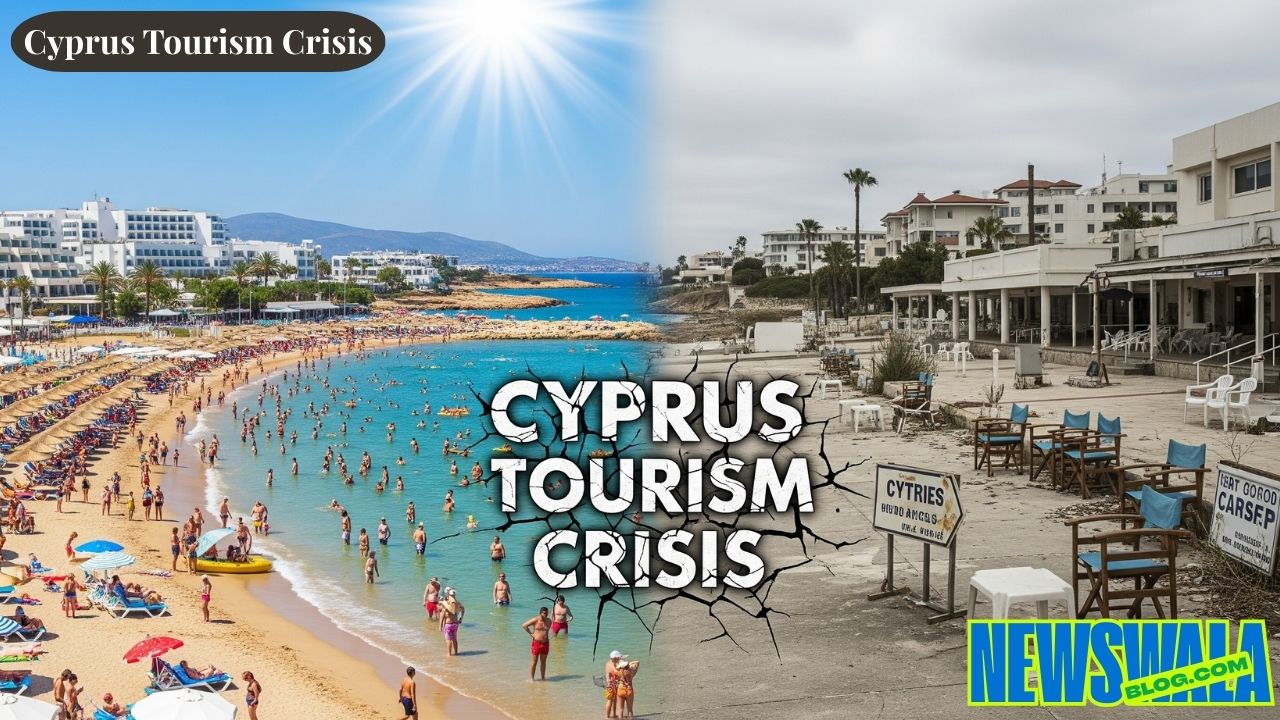
Introduction
The Cyprus tourism crisis has emerged as one of the most significant challenges facing the Mediterranean island nation in recent years. This crisis encompasses a complex web of economic, political, and environmental factors that have fundamentally disrupted the island’s most vital economic sector.
Cyprus has long been recognized as a premier tourist destination, with its pristine beaches, rich cultural heritage, and favorable climate attracting millions of visitors annually. Before the current challenges, tourism contributed approximately 25% to the country’s GDP and employed over 20% of the workforce, making it the backbone of the Cypriot economy.
The Cyprus tourism industry crisis represents more than just declining visitor numbers—it reflects a broader transformation in global travel patterns, economic uncertainties, and changing consumer preferences that have collectively challenged traditional tourism models across the Mediterranean region.
Key Factors Contributing to the Crisis

Economic Challenges
The economic landscape has played a crucial role in shaping the current difficulties facing Cyprus’s tourism sector. Global economic downturns have significantly affected tourist spending patterns, with travelers becoming increasingly budget-conscious and selective about their destination choices.
Currency fluctuations have created additional affordability issues for international visitors, particularly those from key markets such as the United Kingdom and Germany. These economic pressures have made Cyprus less competitive compared to alternative Mediterranean destinations that offer similar experiences at lower costs.
Rising operational costs for tourism businesses have further complicated the situation. Hotels, restaurants, and tour operators have struggled with increased energy costs, higher wages, and inflation, forcing many to raise prices during an already challenging period when demand has been declining.
Geopolitical Issues
Regional conflicts and political tensions have significantly impacted travel confidence among potential visitors. The ongoing geopolitical uncertainties in the Eastern Mediterranean have created concerns about safety and stability, despite Cyprus maintaining its reputation as a safe destination.
Political tensions have also affected tourist perceptions, with some travelers avoiding the region entirely due to misunderstandings about local conditions. Visa and travel restriction complications have added another layer of difficulty, making it more challenging for visitors from certain countries to plan trips to Cyprus.
Infrastructure and Service Quality Concerns
The island’s tourism infrastructure, developed primarily during the boom years of the 1980s and 1990s, has shown signs of aging. Many hotels and resort facilities require significant modernization to meet contemporary traveler expectations and compete effectively with newer destinations.
Service quality concerns have emerged as repeated issues in visitor feedback, with some tourists reporting inconsistent experiences across different sectors of the hospitality industry. This has become particularly problematic as social media and online reviews now play a crucial role in destination selection.
Competition from other Mediterranean destinations has intensified, with countries like Greece, Turkey, and Croatia investing heavily in tourism infrastructure and marketing campaigns, often offering similar experiences at more competitive prices.
Environmental Concerns
The effects of overtourism on natural resources have become increasingly apparent, particularly during peak summer months. Popular beaches and archaeological sites have experienced strain from visitor volumes that sometimes exceed sustainable capacity.
Climate change impacts have altered traditional seasonal patterns, with extreme weather events and rising temperatures affecting the timing and duration of peak tourist seasons. These changes have forced both businesses and travelers to adapt their expectations and planning approaches.
Sustainability challenges have become more prominent as environmentally conscious travelers increasingly seek destinations that demonstrate commitment to ecological responsibility and conservation efforts.
Immediate Impacts
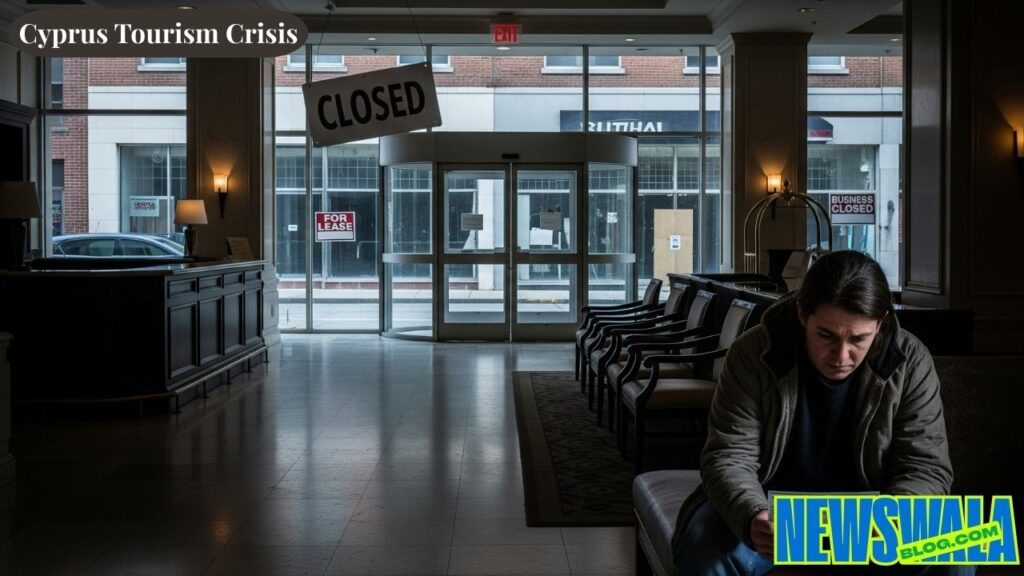
Economic Consequences
The cyprus tourism bookings drop has resulted in substantial revenue losses across the tourism sector. Hotels have reported occupancy rates falling well below profitable levels, with some properties forced to close temporarily or reduce their operational seasons.
Job losses and unemployment in hospitality have affected thousands of Cypriot workers and seasonal employees from other countries. The ripple effect has extended beyond direct tourism employment to impact supporting industries, including construction, retail, and transportation.
Reduced foreign exchange earnings have affected the country’s balance of payments, limiting the government’s ability to invest in infrastructure improvements and economic development programs. The impact on related industries has been particularly severe, with restaurants, transport companies, and retail businesses experiencing significant declines in revenue.
Social Effects
Community displacement in traditional tourist areas has become a growing concern, as local residents struggle with rising living costs and changing neighborhood dynamics. The loss of traditional livelihoods has particularly affected fishing communities and artisans who previously benefited from tourist interest in local culture and products.
Social inequality issues have emerged as some communities have been disproportionately affected by the tourism downturn, while others have remained relatively stable due to more diversified economic bases.
Government and Industry Response

Policy Interventions
The Cypriot government has implemented emergency financial support measures to help struggling tourism businesses survive the crisis period. These have included loan guarantee schemes, tax deferrals, and direct subsidies for businesses that maintain employment levels.
Marketing and promotional campaigns have been launched to restore confidence in Cyprus as a safe and attractive destination. These efforts have focused on key markets and emphasized the island’s unique cultural offerings, natural beauty, and improved health and safety protocols.
Infrastructure investment programs have been accelerated to address some of the long-standing issues affecting tourism competitiveness. These investments include airport improvements, road upgrades, and the modernization of public facilities in major tourist areas.
Industry Adaptation
Tourism businesses have begun diversifying their offerings to attract different market segments and reduce dependence on traditional sun-and-beach tourism. This has included developing cultural tourism, adventure activities, and business travel facilities.
Digital transformation initiatives have been implemented across the industry, with businesses investing in online booking systems, digital marketing capabilities, and contactless service options that have become increasingly important to travelers.
Health and safety protocol implementations have become standard across the hospitality sector, with businesses adopting enhanced cleaning procedures, social distancing measures, and health monitoring systems to reassure visitors about their safety.
Recovery Strategies and Solutions
Short-term Measures
Crisis communication strategies have focused on maintaining transparency about local conditions while highlighting positive developments and safety measures. These efforts have targeted key source markets through traditional and digital media channels.
Targeted market recovery plans have been developed to focus resources on the most promising visitor segments and geographic markets. These plans recognize that recovery may be uneven across different types of tourism and source countries.
Health and safety reassurance campaigns have become a central component of marketing efforts, emphasizing Cyprus’s commitment to visitor well-being and its success in managing public health challenges.
Long-term Sustainable Development
Tourism product diversification has emerged as a key strategy for building resilience against future crises. This includes developing year-round attractions, cultural experiences, and specialized tourism niches that can attract visitors during traditionally slower periods.
Sustainable tourism practices are being integrated into development planning, with emphasis on environmental protection, community involvement, and responsible resource management. These efforts aim to ensure that tourism recovery contributes to long-term economic and environmental sustainability.
Technology integration and innovation have become priorities for modernizing the tourism experience and improving operational efficiency. This includes smart tourism initiatives, mobile applications, and data analytics to better understand and serve visitor needs.
Regional cooperation initiatives are being developed to promote the Eastern Mediterranean as a multi-destination region, potentially allowing Cyprus to benefit from broader tourism flows and shared marketing efforts.
Lessons Learned and Future Outlook
The has provided valuable insights into the importance of economic diversification and crisis preparedness in tourism-dependent economies. Key takeaways include the need for flexible business models, strong digital presence, and robust health and safety protocols.
Predictions for tourism recovery suggest a gradual improvement over the next several years, with domestic and regional tourism likely to recover first, followed by longer-haul international markets. The recovery timeline will depend on various factors including global economic conditions, geopolitical stability, and continued adaptation by the tourism industry.
Building resilience against future crises has become a priority, with emphasis on developing multiple revenue streams, maintaining financial reserves, and creating adaptable business models that can respond quickly to changing conditions.
The potential for sustainable tourism model transformation represents an opportunity to emerge from the crisis with a more resilient and environmentally responsible tourism sector that can provide long-term benefits to both visitors and local communities.
Conclusion
The cyprus tourism industry crisis has presented significant challenges but has also created opportunities for positive transformation. The combination of government support, industry adaptation, and strategic planning provides a foundation for eventual recovery and long-term sustainability.
Recovery progress has been gradual but steady, with some sectors showing signs of improvement as confidence returns and travel patterns normalize. The focus on diversification, sustainability, and innovation positions Cyprus to potentially emerge stronger from this challenging period.
Stakeholders across the tourism ecosystem must continue working together to implement comprehensive recovery strategies while building the resilience necessary to handle future challenges. The lessons learned from this crisis will be valuable for ensuring that Cyprus’s tourism sector can thrive in an increasingly competitive and unpredictable global environment.
Also Read: Costa del Sol Sea Brown Complete Guide for Travelers
Trending
-

 Celebrity2 months ago
Celebrity2 months agoPeter Kay Weight Loss The Incredible Transformation of Britain’s Beloved Comedian
-

 Entertainment1 month ago
Entertainment1 month agoErazno y La Chokolata The Ultimate Hispanic Comedy Radio Experience
-

 Food & Drink1 month ago
Food & Drink1 month agoDiscover the Authentic Taste of Бишкоти ди Прато Italy’s Most Beloved Almond Biscuits
-

 Entertainment1 month ago
Entertainment1 month agoThe Complete Guide to Crusader Crossword Puzzles
-

 Celebrity2 months ago
Celebrity2 months agoJalen Green Girlfriend Complete Guide to His Dating Life and Relationships
-

 Entertainment1 month ago
Entertainment1 month agoKirby Dedo The Ultimate Guide to Kirby Finger Puppets and King Dede Collectibles
-

 News2 months ago
News2 months agoManchester City 115 Charges Verdict Everything You Need to Know About the Historic Case
-

 Business2 months ago
Business2 months agoUK Printer Security Alerts A Complete Guide to Protecting Your Organization

